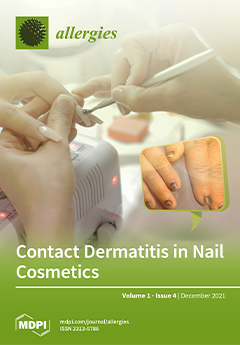Atopic dermatitis (AD) is a chronic relapsing skin disease, associated with impaired skin barrier function and characterized by poorly defined pruritic, erythematous lesions. In this study, the efficacy of a new topical cream (IALUSET VITAL
®), containing hyaluronic acid and the extract
[...] Read more.
Atopic dermatitis (AD) is a chronic relapsing skin disease, associated with impaired skin barrier function and characterized by poorly defined pruritic, erythematous lesions. In this study, the efficacy of a new topical cream (IALUSET VITAL
®), containing hyaluronic acid and the extract of
Salvia haenkei, in reducing symptoms of moderate AD in adults was investigated. This study was a randomized, double blind, vehicle-controlled clinical study. Treatment efficacy was evaluated considering both objective parameters (Scoring Atopic Dermatitis, SCORAD) and subjective pa-rameters (Patient Oriented Eczema Measure, POEM, and an itching sensation) and through non-invasive bioengineering techniques to measure skin moisturization and Trans Epidermal Water Loss (TEWL). Under the experimental conditions of the study, IALUSET VITAL
® significantly reduced AD severity, as shown by the SCORAD index, and was revealed to be effective in alleviating the most common signs and symptoms of moderate AD, suppressing itch and improving skin moisturization, and to have a good safety profile, being well-tolerated by patients. However, statistically significant differences between active and vehicle group were not found in the other parameters analyzed, likely because the basic formulation of IALUSET VITAL
® guarantees good emollient properties and the addition of hyaluronic acid and extract of
Salvia haenkei as active ingredients results in a great increase in effectiveness.
Full article



